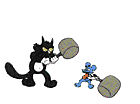Most literature mentions that Plumheads can be choosy with their mates, so armed with this knowledge I set off to the Goulburn Valley sale in may 1998. I managed to buy 2 cocks from one breeder and two hens from another, all the birds I selected were nearly fully colored juveniles. Later checking my licence records I noticed the breeders addresses were 300 Km apart, this pleased me, as it was less likely they were related.
As mentioned earlier there are nesting areas both inside the roosting shed and along a sheltered wall in the wire-roofed flight. My Gouldians will nest inside or out, the Painteds nest inside 80% of the time, the parrot finches are always inside the shelter and the Plumheads, Diamonds and Cubans always nest in the brush under the sheltered section of the flight, without exception. The Diamonds in my aviary don't let any species nest within about � a metre of their nest (even other Diamonds), but for some reason will allow Plumheads to nest right next to them sometimes both bird's nest entrances are only inches apart. On several occasions I have observed a Diamond chase 6 assorted birds (including Diamonds) away from the perch closest their nest, then a Plumhead arrives on the same perch and enters its own nearby nest, unmolested. Usually the Plumhead parent waits until the Diamond is chasing another bird away to enter their nest, but occasionally they enter in full view of the Diamond parent but invariably they are ignored.
Although I don't look in nests, other literature states that Plumheads take around 12 days to hatch and 21 days to fledge. Unlike a lot of species, young rarely fledge before they are capable of flight (which is one less thing to worry about). They regularly fledge 3-5 young from early spring to late autumn, with the occasional nest in winter. I separate fledglings from their parents 21 days after fledging, but I leave them for an extra week in winter and for first year pairs. A lot of literature states that they will desert their nest if you look in it, I have believed this and have never looked, so I can't tell you whether mine are tolerant of this, The nest is fully enclosed and made from the grass-seed they feed on and lined with feathers, usually they make a new nest each clutch. Most of the time the 3 pairs in the aviary have young fledge a few weeks apart, on one occasion they were a lot closer, so knowing there were more due out soon I put rings on the first lot so I would know them apart. Soon after 2 more nests fledged and after a few days they all looked the same, I thought the parents would know the difference but all 6 parents fed all young who begged completely randomly.
Health.
My finches are regularly wormed and liced, but I think good housekeeping, clean water and feed along with adequate housing go a long way towards keeping my birds healthy. I haven't had any health or injury problems with Plumheads at all. Rarely does a fledgling die and I still have the same pairs breeding and have formed new pairs with their young combined with new blood.
Cats and Vermin.
Mice. Galvanised iron sheet surrounds the base of the aviary, it is 300 mm above ground and is dug in 600 mm, at the bottom of the trench I added a concrete buffer which extends away from the aviary 150 mm. The theory is that a mouse will burrow down but when he hits the concrete he will not tunnel away from the aviary. Other ideas I have heard is to put broken glass in the bottom of the trench or charcoal ( I've heard mice cannot burrow through charcoal). Mice can walk through regular bird wire, so I use the square welded mesh (11 mm), you can buy mouse proof 9 mm wire but it's very expensive and hard to see through. Mice can only pass through 11 mm wire up until around 21 days old and are independent of their parents at 12 days. If the manage to get in I have solid baits inside the storage area at the rear of the aviary were the birds cannot get to.
Cats. I was finding cats on the wire roof at night when a very experienced fellow aviculturist John Carty showed me his electric fence, he's fond of adding ("it'll keep the kids off too"). Soon I purchased a unit and ran a 'hot-wire" around the roof and base. I raised the wire by 150 mm on fibreglass posts and earthed both the wire and roof to the mouse proof sheeting. When cats go through spaces they feel their way through using their whiskers and tail, making it impossible for them to miss hte hotwire. The fence is high volts but low amps, so it gives a harmless static shock which does not harm the cat (or possum). Cats soon learn and won't return after being shocked. These units are inexpensive ( mine was under $200 complete with wire, poles and clips) and easy to set up, you can purchase units that run on 1 (DD) battery, car batteries or mains like mine.
After the fence was set up all the birds that were mentioned earlier that breed in the flight started to raise more young.
Summary.
These interesting finches will not harm any other birds and are generally healthy and easy to keep and breed, their crimson heads are quite stunning when viewed in direct sunlight. I wouldn't hesitate to recommend them to anyone. A schedule 1 licence is required in Victoria.

